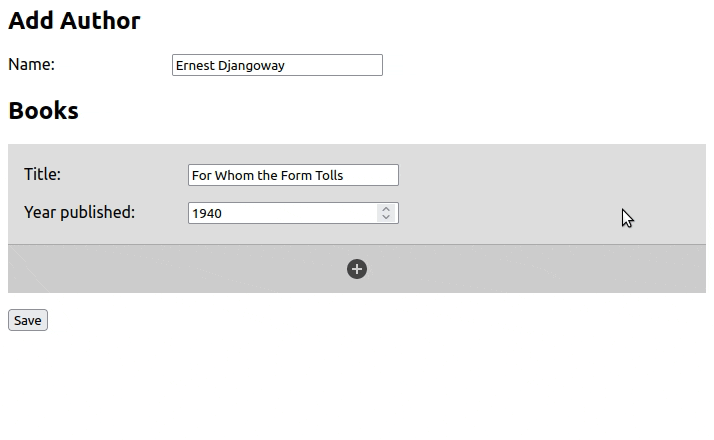A Django app and pure JavaScript library to manage formsets
Project description
django-fancy-formset
This is a plain JavaScript library to let users add and remove forms in a Django inline formset. It can be installed from PyPI as a Django app, from NPM as a JavaScript module, or linked to directly from your HTML.
Features:
- No dependencies, just 5kB of plain JavaScript
- Apply to formsets manually, or automatically via a
data-attribute - Optional Django app to simplify usage
- Raises events to allow for customisation
- Class based and designed to be extended
- Default styling available

Quickstart using Python
Install with:
pip install django-fancy-formset
Add to your INSTALLED_APPS, then create your formsets using the provided
fancy formset classes:
from fancy_formset import FancyInlineFormSet
BookInlineFormSet = forms.inlineformset_factory(
Author, Book, formset=InlineFancyFormSet,
)
then leave it to Django to render your formset:
{{ formset.media }}
<form method="post">
{% csrf_token %}
{{ form.as_p }}
{{ formset.as_p }}
<button type="submit">Save</button>
</form>
See the Django installation documentation for more details
Quickstart using JavaScript
The Python package is a thin wrapper around the JavaScript package. For more control, you can integrate it yourself.
Add to your page directly using unpkg:
<html>
<head>
<!-- Optional styles -->
<link rel="stylesheet" href="https://unpkg.com/django-fancy-formset@^1/dist/formset.min.css">
</head>
<body>
<!-- Django formset goes here -->
<script src="https://unpkg.com/django-fancy-formset@^1"></script>
<script>formset.init();</script>
</body>
</html>
You can also use it in your bundler or browser as module - see the JavaScript-only installation documentation for more details
Render your formset in your Django template. The template structure which will work with the default configuration is:
<form method="post">
{% csrf_token %}
{{ form.as_p }}
<h2>Formset</h2>
<div data-formset="{{ formset.prefix }}"> {# Formset container to target #}
{{ formset.management_form }} {# Add the management form #}
<fieldset style="display: none"> {# Add and hide the empty form #}
{{ formset.empty_form.as_p }}
</fieldset>
{% for form in formset %}
<fieldset> {# Each formset form has a container #}
{{ form.as_p }} {# Actual form layout doesn't matter #}
</fieldset>
{% endfor %}
</div>
<button type="submit">Save</button>
</form>
This can all be customised with options passed as formset.init(options) - see the
configuration documentation
for details.
Find out more
For full installation and usage instructions, as well as information on events, the API and customisation, see the documentation.
Project details
Download files
Download the file for your platform. If you're not sure which to choose, learn more about installing packages.
Source Distribution
Built Distribution
Hashes for django-fancy-formset-1.0.0.tar.gz
| Algorithm | Hash digest | |
|---|---|---|
| SHA256 | 9c39071d5e29cae9170132c3ffb3274f8a0272dc0555cf6c52f2fde083424241 |
|
| MD5 | e50d039ba909b6a72917eb5ed8523c53 |
|
| BLAKE2b-256 | 662ed6f2a782d07dc3c51460a8f948dda4d296677a2c7a98d8d7e15a4d5e929c |
Hashes for django_fancy_formset-1.0.0-py3-none-any.whl
| Algorithm | Hash digest | |
|---|---|---|
| SHA256 | c2454d63d115a5c20d337149f7b9e0a9e2d6b6c65db44ee0aba2f2e4a44212f6 |
|
| MD5 | ec5bf78133658e7222b38941bd0c97e9 |
|
| BLAKE2b-256 | 623580a46baa9c09761127fe5844f71ddd9c75ef31254be60db8da4f55d5402d |















